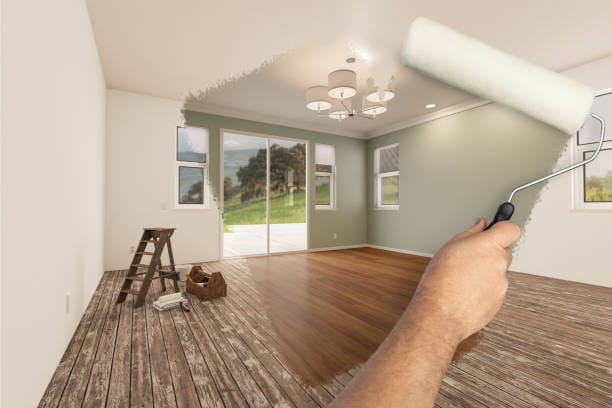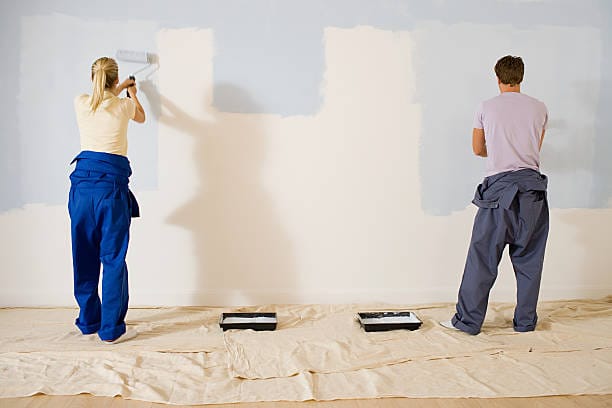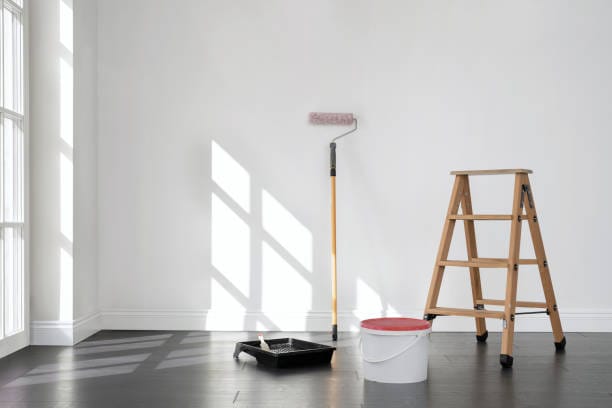
Why Home Renovation Painting is Key to a Successful Remodel
A well-executed paint job does more than refresh a space—it defines the final look, enhances durability, and adds value to home remodel projects. The right colors create ambiance, while quality finishes protect surfaces from daily wear. Skipping or rushing this step can leave even the most well-planned renovation feeling incomplete.
Here are five key ways home renovation painting ensures a successful home remodel.
Table of Contents
Key Takeaways✔ A well-planned home renovation painting schedule prevents delays and ensures a smooth workflow in home remodel projects. ✔ Choosing the right paint colors based on room size and natural light enhances both aesthetics and functionality. ✔ High-quality home renovation painting protects walls from moisture, stains, and daily wear, extending the life of a remodel. ✔ A fresh coat of paint increases home value by making spaces look modern, well-maintained, and move-in ready. ✔ Thoughtful color selection influences mood and productivity, making rooms feel more inviting, calming, or energizing. ✔ Coordinating paint with flooring, cabinets, and fixtures ensures a cohesive, balanced design throughout a remodel. ✔ Proper surface preparation, drying time, and application techniques result in a long-lasting, professional finish. |
1. Enhances Aesthetic Appeal and Cohesion
A fresh coat of paint is one of the most noticeable upgrades in any home remodel project. It ties together new design elements, creating a polished and cohesive look. Without proper attention to home renovation painting, even high-end renovations can appear incomplete or mismatched.
Why Paint Impacts the Overall Look of a Successful Home Remodel
- Defines the Style of a Space: Color choice sets the tone for a room, whether modern, classic, or eclectic. A well-chosen palette enhances architectural details and complements furniture, flooring, and decor.
- Creates Visual Flow Between Rooms: Consistent color schemes across different areas make a home feel more connected. Painting for home renovations ensures smooth transitions, preventing abrupt or clashing color changes that disrupt the overall design.
- Enhances Natural and Artificial Lighting: Lighter paint colors reflect natural light, making rooms feel more spacious and inviting. Darker shades add warmth and depth, helping to create cozy, intimate spaces in home remodel projects.
How to Use Paint Strategically in Home Remodel Projects
- Choose the Right Undertones: Even neutral shades have warm or cool undertones that can affect the look of a space. Understanding how undertones interact with lighting and furnishings ensures home renovation painting enhances rather than clashes with the design.
- Incorporate Accent Walls for Dimension: A bold or contrasting color on a single wall adds depth and character without overwhelming a room. This technique is an effective way to experiment with color in painting for home renovations while maintaining balance.
- Use Paint to Highlight Architectural Features: Trim, molding, and built-ins stand out with carefully selected paint colors. A slightly lighter or darker shade than the walls can subtly emphasize these details, adding sophistication to a successful home remodel.
2. Protects Surfaces and Increases Durability
A remodel isn’t just about looks—it’s also about longevity. Home renovation painting acts as a protective barrier, shielding surfaces from wear, moisture, and damage. Investing in high-quality paint extends the life of walls, ceilings, and trim, ensuring a successful home remodel lasts for years.
Why Paint Preserves and Strengthens Surfaces
- Prevents Moisture Damage: Bathrooms, kitchens, and basements are prone to humidity, which can lead to mold and mildew. Using moisture-resistant paint in these spaces protects walls from water stains and long-term deterioration.
- Reduces Scuffs and Scratches: High-traffic areas like hallways, stairwells, and living rooms need durable paint that resists daily wear. Semi-gloss and satin finishes hold up better than flat paint, making them ideal for painting for home renovations.
- Seals and Smooths Imperfections: Paint helps conceal minor wall flaws, such as small cracks or uneven textures. Priming before painting fills in porous surfaces, providing a smooth, even finish in home remodel projects.
How to Maximize Paint’s Protective Benefits
- Use the Right Finish for the Right Space: Matte and flat paints hide imperfections but stain easily, while satin and eggshell offer durability with a soft sheen. For trim and cabinets, high-gloss paint provides a tough, wipeable surface.
- Apply a Quality Primer First: Primer helps paint adhere properly, preventing peeling or chipping over time. In high-moisture areas, mold-resistant primers add extra protection for a successful home remodel.
- Choose Washable Paints for High-Use Rooms: Kitchens, bathrooms, and kids’ rooms benefit from scrubbable, stain-resistant paint. These specialty formulas allow easy cleaning without damaging the surface, ensuring home remodel projects stay fresh-looking longer.
3. Increases Home Value and Buyer Appeal
A well-painted home feels fresh, updated, and move-in ready, making it a smart investment in a booming industry—especially as the home improvement market grew by 26% in 2023, reaching $475 billion. Buyers notice details, and home renovation painting can make a strong first impression. Whether selling soon or in the future, a strategic paint job adds value to home remodel projects and attracts potential buyers.
Why Paint Affects Resale Value
- Creates a Modern, Well-Maintained Look: Outdated or faded paint can make a home feel neglected, even after a remodel. Fresh, neutral tones appeal to a wider audience and make spaces feel new.
- Highlights Renovation Investments: Painting for home renovations ensures that new countertops, flooring, and fixtures stand out. A well-matched color scheme enhances these upgrades, making them feel intentional and high-end.
- Boosts Curb Appeal Instantly: The exterior is the first thing buyers see, and a faded or peeling facade can be a deal-breaker. A fresh coat of paint on siding, doors, and trim signals that a home is well cared for.
How to Use Paint to Attract Buyers
- Stick to Neutral and Timeless Shades: Soft grays, warm beiges, and crisp whites create a clean slate for potential buyers. These colors make spaces look larger and allow them to envision their own décor.
- Refresh Key Areas First: If a full repaint isn’t possible, focus on high-impact areas like the front door, kitchen, and bathrooms. These spaces influence buyer perception and can significantly affect a home’s value.
- Ensure a Flawless Finish: Uneven coats, drips, or streaks can make a home look poorly maintained. Professional-quality application, including clean edges and even coverage, contributes to a successful home remodel.

4. Enhances Mood and Functionality
Color is more than just decoration—it influences mood, signals action, and even affects physiological responses, making paint a key factor in how a space feels and functions. Thoughtful color choices can make rooms more inviting, productive, or relaxing, depending on the purpose. In home remodel projects, the right paint enhances both comfort and usability.
Why Color Impacts Mood and Use of Space
- Encourages Productivity in Workspaces: Home offices and study areas benefit from shades that promote focus. Soft blues, greens, and muted grays create a calm environment, reducing stress and improving concentration.
- Promotes Relaxation in Bedrooms and Living Areas: Warm neutrals and earth tones foster a sense of tranquility. Painting for home renovations with soothing colors makes spaces feel more restful and inviting.
- Energizes Social and Creative Spaces: Kitchens, dining rooms, and play areas can benefit from vibrant hues. Soft yellows, warm oranges, or rich jewel tones add warmth and stimulate conversation and creativity.
How to Use Paint to Improve Functionality
- Consider Light Reflectance: Lighter colors make small spaces feel bigger, while darker tones create cozy, enclosed environments. Using home renovation painting strategically helps balance natural and artificial lighting.
- Use Different Finishes for Different Needs: Matte paint minimizes glare in home theaters, while semi-gloss resists moisture in bathrooms. Choosing finishes based on room function ensures a successful home remodel.
- Incorporate Contrast for Definition: Darker trim against light walls—or vice versa—adds visual interest. This technique is useful in painting for home renovations where defining architectural details matters.
5. Complements Fixtures, Flooring, and Décor
Why Paint Complements Other Remodel Elements
- Balances Bold Fixtures and Finishes: Statement lighting, patterned tile, or unique hardware stand out more against the right backdrop. Neutral or muted wall colors allow bold design elements to shine without overwhelming the space.
- Unifies Open-Concept Layouts: In modern home remodel projects, open floor plans require thoughtful color choices. Painting for home renovations with a cohesive palette prevents visual fragmentation and creates flow between spaces.
- Bridges Old and New Design Features: Renovations often mix existing features with new upgrades. Using transitional color tones helps blend elements like original hardwood floors with freshly installed cabinetry.
How to Choose Paint That Works with Other Design Elements
- Test Paint Swatches with Flooring and Cabinets: Natural and artificial lighting can affect how colors appear. Sampling paint alongside materials ensures a cohesive final look.
- Use a Monochromatic or Complementary Color Scheme: A slight variation of the same hue across walls, trim, and ceilings creates depth. For contrast, complementary colors on the color wheel add visual interest without clashing.
- Adjust Paint Tones for Different Materials: Warm-toned woods pair well with creamy whites and earthy shades. Cooler materials like gray tile or stainless steel stand out against crisp blues or charcoal tones in home remodel projects.
How to Plan Home Renovation Painting for Maximum Efficiency
A well-planned painting process keeps home remodel projects on track and prevents costly mistakes. Rushing into painting before other renovations are complete can lead to damaged finishes, rework, and unnecessary delays. By organizing tasks strategically, home renovation painting can be completed smoothly while ensuring long-lasting, high-quality results.
1. Schedule Painting After Major Renovations Are Complete
2. Choose Paint Colors and Finishes Early in the Process
3. Plan for Drying and Curing Time Between Coats
4. Protect Surfaces and Fixtures Before Starting
5. Organize Supplies and Set Up an Efficient Workspace

How to Choose Paint Colors Based on Room Size and Natural Light
Paint color plays a crucial role in how a space feels, affecting both perception and functionality. The right shades can make small rooms appear larger, balance overly bright areas, or add warmth to dim spaces. When planning home renovation painting, considering room size and natural light helps create a balanced, visually appealing home remodel project.
1. Use Light Colors to Make Small Rooms Feel Larger
2. Choose Darker Tones to Add Depth to Large or Oversized Spaces
3. Adjust Paint Colors Based on the Room’s Natural Light Exposure
4. Use Reflective Paint Finishes to Enhance Light in Dim Spaces
5. Test Paint Samples in Different Lighting Before Committing
Frequently Asked Questions (FAQs)
How does humidity affect home renovation painting?
Humidity plays a significant role in how paint adheres and dries. High humidity slows drying times, leading to streaks, uneven coverage, and potential mold growth in home remodel projects. Painting for home renovations in humid conditions requires using dehumidifiers, fans, or air conditioning to maintain optimal drying. For best results, painting should be done when humidity levels are below 50% to ensure a smooth, long-lasting finish.
What is the best way to paint over dark-colored walls?
How can home renovation painting help reduce indoor odors?
Can textured walls be painted the same way as smooth walls?
How can exterior home renovation painting withstand harsh weather conditions?
Flawless Paint, Lasting Results—Call Prospect House Painting Pros
A quality paint job is the finishing touch that pulls a remodel together, adding both style and durability. Prospect House Painting Pros provides expert home renovation painting in Prospect, CT, ensuring crisp lines, smooth coverage, and long-lasting color. Whether tackling a full home remodel or refreshing a single room, their team works with precision and efficiency.
Give your home the polished, professional look it deserves—contact them today to get started!
